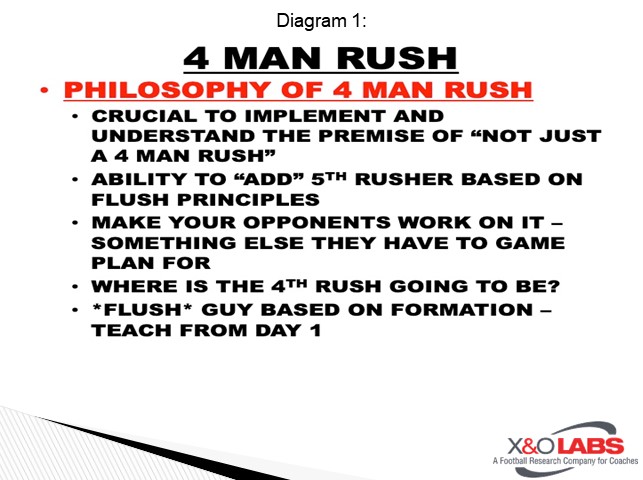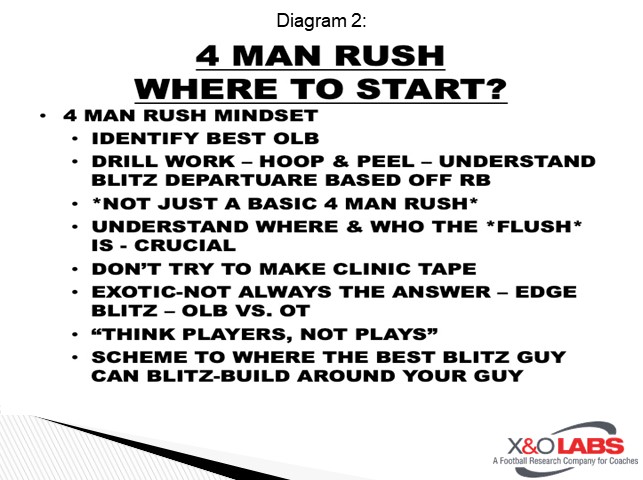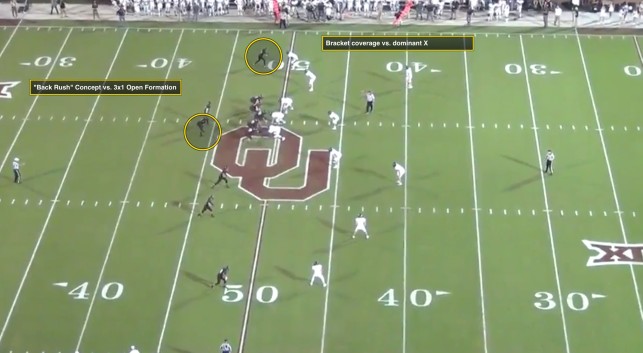By Ty Gower
Defensive Coordinator
Princeton High School (TX)
Twitter: @coachgower
As a 3-4, we base in the popular mint/tite front (4i-0-4i), or what we call “Okie” front, that has become more common as the clinic tapes, coaches’ lectures, and other teaching material becomes available. There are many reasons as to why we love the Okie front, but like every defense, this defense has its strengths and weaknesses. I learned long ago that, "Whatever your defensive philosophy is, you must identify the weaknesses of your favorite defense as much as the strengths." As we have found out, and as you will read, this is one of these schematic ideas that is understood through reading and chalk talks but also needs video representation to explain the point further.
Benefits of Okie Front:
Let’s start with some of the strengths of the Okie front
Troubleshooting 4-Man Pressures:
The ability to rush any 4 of the ILB or OLB anywhere we want and at any time is vital to incorporate into your 3-4 defense. When we first were learning about the 3-4, we were implementing a 4-man rush, just to install a 4-man rush. We would go through spring ball and run a 4-man OLB rush, but not getting the results we wanted. We later realized that the away side of the rush was just as vital to coach as the front side OLB rush. So we came to find out, #5 had a dilemma, and we had to coach up the 4-man rush, more than just “install the 4-man rush.”
As much as we like strength #5, this strength does come with a weakness. We found that we had two glaring weaknesses within bringing a 4-man rush out of 4i-0-4i. ***Disclaimer - We can and do slant the front when we are bringing our OLB, but as a base, we want to stay within the 4i-0-4i front, as will be described in this article.***


Problem #1. How do we keep our various Cover 4 2x2 and 3x1 checks? We did not want to void "cover down zones." Meaning - when we 4-man rushed an OLB, we did not want to void his alignment and play 2 over 2. The initial thought was to spin to cover 3, and play a 4 under, 3 deep concepts, but here came a dilemma, we didn’t play much cover 3. That’s just not what we do. We were a two-high coverage concept defense. Yes, we played some cover 3, and do use it to cover down the OLB at times, but we didn’t run it enough to major in the coverage, especially since we wanted to major in a 4-man rush. Thus, we had to figure out how to rush 4 and still play 3 over 2, Quarters concept and not always spin cover 3. We will identify how we covered the OLB later in the article.
Problem #2. We found out that when we want to bring a 4-man OLB rush, we were unable to set a "hard edge" opposite of the OLB rush due to us playing a 4i across the front, thus lacking what we would later determine as a "flush player" to help us with our edge. What we found out was when we install our 4-man OLB rush, we must teach our away side "flush principles" based on the offensive formation. In turn, this gave us the ability to call a 4-man rush from the sideline but allow the kids to add themselves to the rush based on the offensive formations and giving us a 5-man pressure.

Flush Principles:
Our kids began to love the idea, due to the fact it gives them some freedom to become a rusher/blitzer based off the following:
When we called a 4-man OLB rush, we were getting a 5-man blitz based on offensive formation, but again, understand that the 5-man pressure was NOT called. It’s incorporated and understood by our kids and taught during the offseason.
When we start our spring install, we first install our two OLB “blitzes”. Our strong/field OLB is the Nickel and our weak/boundary OLB is the Jack. We don’t necessarily call our 4-man ILB/OLB a true blitz, but rather a 4-man rush, with a 5-man pressure built into the rush based on “flush principles”. Yes, we still implement our 5-man fire zone blitzes, but the absolute first install is our OLB 4 man rush and teaching our kids the flush principles.
Now, when it comes to the technique of the OLB rush, we aren’t doing anything different than anybody else. We work all the leverage drills, hoop drills, rush drills that everyone else does, but where we think we are unique is our research in refining our OLB 4-man rush by adding a 5th rusher with the “flush” concept.
As stated earlier, one of the great things about the 3-4 is the ability to rush any of our 4 ILB/OLB at any time. However, when we start, we want to identify our “hybrid guys”. Who is our Nickel and who is our Jack? After we have identified those positions, we discuss who becomes the “cover down” and who becomes the “flush player.”
Let’s first identify our Nickel and will be the focus of this article. In our defense, and with so much of the game played on the hash, our Nickel is our "catch-all". He must be a guy whom we feel can cover, buzz to the flat, blitz the edge, play like a corner in certain coverages, make plays in space, and other various ideas we put on him. Again, out of our Okie front, when we run a Nickel blitz/rush, we feel we can rush him at any time against any formation. Remember the dilemma:
Defensive Coordinator
Princeton High School (TX)
Twitter: @coachgower
As a 3-4, we base in the popular mint/tite front (4i-0-4i), or what we call “Okie” front, that has become more common as the clinic tapes, coaches’ lectures, and other teaching material becomes available. There are many reasons as to why we love the Okie front, but like every defense, this defense has its strengths and weaknesses. I learned long ago that, "Whatever your defensive philosophy is, you must identify the weaknesses of your favorite defense as much as the strengths." As we have found out, and as you will read, this is one of these schematic ideas that is understood through reading and chalk talks but also needs video representation to explain the point further.
Benefits of Okie Front:
Let’s start with some of the strengths of the Okie front
- The “unknown” to the offense of where the bubble is in the 4i-0-4i front, as opposed to playing a shade/3 front.
- The ability to slant & move to any front we want from an odd front structure.
- The ability to “walk” the boundary OLB to help bracket the “X” WR in 3x1.
- The ability to drop 8 and play multiple coverages.
- The ability to rush any 4 of the ILB or OLB anywhere we want and at any time.
Troubleshooting 4-Man Pressures:
The ability to rush any 4 of the ILB or OLB anywhere we want and at any time is vital to incorporate into your 3-4 defense. When we first were learning about the 3-4, we were implementing a 4-man rush, just to install a 4-man rush. We would go through spring ball and run a 4-man OLB rush, but not getting the results we wanted. We later realized that the away side of the rush was just as vital to coach as the front side OLB rush. So we came to find out, #5 had a dilemma, and we had to coach up the 4-man rush, more than just “install the 4-man rush.”
As much as we like strength #5, this strength does come with a weakness. We found that we had two glaring weaknesses within bringing a 4-man rush out of 4i-0-4i. ***Disclaimer - We can and do slant the front when we are bringing our OLB, but as a base, we want to stay within the 4i-0-4i front, as will be described in this article.***


Problem #1. How do we keep our various Cover 4 2x2 and 3x1 checks? We did not want to void "cover down zones." Meaning - when we 4-man rushed an OLB, we did not want to void his alignment and play 2 over 2. The initial thought was to spin to cover 3, and play a 4 under, 3 deep concepts, but here came a dilemma, we didn’t play much cover 3. That’s just not what we do. We were a two-high coverage concept defense. Yes, we played some cover 3, and do use it to cover down the OLB at times, but we didn’t run it enough to major in the coverage, especially since we wanted to major in a 4-man rush. Thus, we had to figure out how to rush 4 and still play 3 over 2, Quarters concept and not always spin cover 3. We will identify how we covered the OLB later in the article.
Problem #2. We found out that when we want to bring a 4-man OLB rush, we were unable to set a "hard edge" opposite of the OLB rush due to us playing a 4i across the front, thus lacking what we would later determine as a "flush player" to help us with our edge. What we found out was when we install our 4-man OLB rush, we must teach our away side "flush principles" based on the offensive formation. In turn, this gave us the ability to call a 4-man rush from the sideline but allow the kids to add themselves to the rush based on the offensive formations and giving us a 5-man pressure.

Flush Principles:
Our kids began to love the idea, due to the fact it gives them some freedom to become a rusher/blitzer based off the following:
- Knowing who the "flush player" is based on the CALLED OLB rush from the sideline.
- Knowing who the "flush player" is based on the offensive formation.
When we called a 4-man OLB rush, we were getting a 5-man blitz based on offensive formation, but again, understand that the 5-man pressure was NOT called. It’s incorporated and understood by our kids and taught during the offseason.
When we start our spring install, we first install our two OLB “blitzes”. Our strong/field OLB is the Nickel and our weak/boundary OLB is the Jack. We don’t necessarily call our 4-man ILB/OLB a true blitz, but rather a 4-man rush, with a 5-man pressure built into the rush based on “flush principles”. Yes, we still implement our 5-man fire zone blitzes, but the absolute first install is our OLB 4 man rush and teaching our kids the flush principles.
Now, when it comes to the technique of the OLB rush, we aren’t doing anything different than anybody else. We work all the leverage drills, hoop drills, rush drills that everyone else does, but where we think we are unique is our research in refining our OLB 4-man rush by adding a 5th rusher with the “flush” concept.
As stated earlier, one of the great things about the 3-4 is the ability to rush any of our 4 ILB/OLB at any time. However, when we start, we want to identify our “hybrid guys”. Who is our Nickel and who is our Jack? After we have identified those positions, we discuss who becomes the “cover down” and who becomes the “flush player.”
Let’s first identify our Nickel and will be the focus of this article. In our defense, and with so much of the game played on the hash, our Nickel is our "catch-all". He must be a guy whom we feel can cover, buzz to the flat, blitz the edge, play like a corner in certain coverages, make plays in space, and other various ideas we put on him. Again, out of our Okie front, when we run a Nickel blitz/rush, we feel we can rush him at any time against any formation. Remember the dilemma:
- How do we cover him up?









